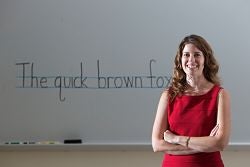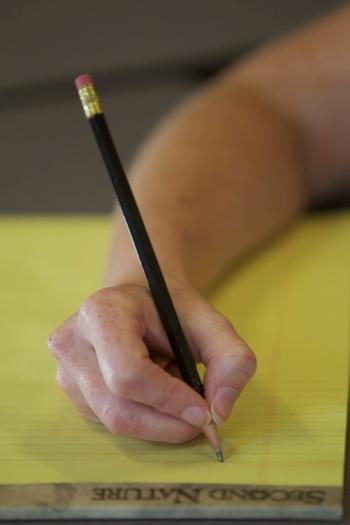Summertime homework: Kids, practice your cursive
Summer is a good time for children who are struggling with handwriting to improve their skills, said an East Carolina University expert.
The break from learning course content gives children time to focus on the actual mechanics of handwriting, said Dr. Denise Donica, assistant professor of occupational therapy in the College of Allied Health Sciences and certified handwriting specialist.

Denise Donica, who teaches occupational therapy at the ECU College of Allied Health Sciences, says summer is a great time for school-aged children to develop their handwriting skills and then practice, practice, practice. (Photo by Cliff Hollis)
Donica offered some suggestions for parents over the school break:
- Encourage writing throughout the summer – lists, greeting cards, writing messages, keeping a diary, etc.
- Encourage craft, assembly and construction play to improve fine motor skills versus activities just requiring the push of a button.
- Seek out an occupational therapist if you have concerns with the child’s handwriting skills.
In addition to teaching ECU occupational therapy graduate students, Donica researches handwriting instruction, reviews tools used, assesses teacher views on writing instruction, and measures the efficacy of handwriting instruction. “Helping children succeed in school is our ultimate goal,” she said.
Some states are phasing in handwriting instruction for teachers, while others are pushing it out, she said. Donica is preparing a journal article on the findings from a survey last year of 505 teachers across North Carolina. “Teachers are saying they aren’t being trained in college to teach handwriting,” she said.
There are two primary forms of handwriting: print or manuscript, and cursive.
Multiple studies show that poor handwriting can lower grades on children’s assignments, even if they know the content. In addition, students taking timed tests, such as the SAT, may be able to get more thoughts down in a shorter amount of time through cursive writing. “But if you can’t read it, it’s a zero,” she said.
Students as young as kindergarten-age often begin journaling, but typically concentrate more on the story rather than the actual writing of letters and words, Donica said.
Handwriting remains an important skill even in the digital age, she said. She compares it to math. “We have calculators, computers, but you still have to know how to add or tell time,” she said. “Those are basic concepts. It’s the same with handwriting.”
Before joining ECU, Donica was an occupational therapist in the Indiana public school system and in outpatient pediatric rehabilitation, where she assisted children with fine motor and visual motor challenges which often show up in handwriting.
She received bachelor’s degrees in psychology/criminal justice and occupational therapy from Indiana University, and a master’s degree and a doctorate in occupational therapy from the University of Indianapolis. She is a certified trainer in Handwriting Without Tears, a curriculum that uses hands-on methods to teach children how to write legibly and fluidly, making it an automatic skill.
Dr. Carol Lust, associate professor of occupational therapy, said Donica has been a wonderful addition to ECU. “The energy, dedication and enthusiasm Denise puts into her work is commendable,” Lust said. “The research she is doing in handwriting will add important evidence to our profession in the area of pediatrics.”
Donica’s doctoral topic was on the history of handwriting instruction, and how occupational therapists became involved in the 1970s through specialized education plans in the public schools. Students struggling with written communication often were referred to an occupational therapist to improve fine motor skills.
“Up until 1922, in the United States, everyone wrote in cursive,” she said. “If you think of the Declaration of Independence or other historical documents, they are all in cursive.”
A woman attending a conference in England in the 1920s learned about print and brought it back to the United States. Two years later, she denounced it, Donica said.
“We teach print and we teach cursive, but there is this push and pull. The literature supports both,” Donica said.
Kindergarten is an ideal time to teach print or manuscript to a typically-developing child based on Donica’s research. There are precursors to readiness such as recognizing shapes, letters, coloring, and being able to trace letters. By first and second grade, students are mastering skills and should have a basic understanding of letters and writing. Third grade is typically when cursive writing is taught.
A mature handwriting grasp is called a “tripod,” described as the gold standard, with the thumb and index finger located opposite one another on the pencil or pen. “When you’re writing, you’re really just using the first three fingers,” Donica said. “The last two fingers are often used as a stabilizer.”
Keyboarding and texting use different visual and fine motor skills and muscle control than handwriting, she said. Keyboarding uses all the digits, while texting mainly involves thumbs or index fingers, similar to playing video games.
This summer, Donica’s graduate students will assist Winnie Miller, an occupational therapy practitioner in the pediatric outpatient rehabilitation unit at Pitt County Memorial Hospital, in helping children with handwriting skills. “The students enjoy it,” Donica said.

Denise Donica demonstrates the correct way to hold a pencil using the tripod grasp. “When you’re writing, you’re really just using the first three fingers,” Donica said. (Photo by Cliff Hollis)